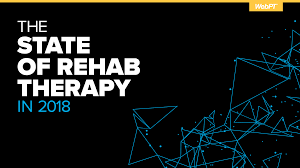
—
Listen to the podcast here:
WebPT’s Heidi Jannenga Part 2 – Earn $150k More by Doing This!
 This is part two of my interview with Heidi Jannenga of WebPT. In the previous episode, I shared her bio and story. We discussed some of the issues related to physical therapy ownership and our lack of marketing and growth strategies. This is all related to WebPT’s report called the State of Rehab Therapy in 2018 where they surveyed over 7,000 respondents in the rehab industry. We talked about marketing and growth strategies in the first episode. In this part, we go into three of the four topics that stood out in the report but the main one being is that we’re losing money. We’re losing hundreds of thousands of dollars in our PT clinic businesses simply because patients aren’t completing their plans of care. Heidi and I talked into that a little bit as well as a couple of the other topics that came from the WebPT report. If you want to learn more about Heidi and her story, go back to the previous episode. In this episode, we’re going to move forward into the conversation and talk about the rest of the results from their report.
This is part two of my interview with Heidi Jannenga of WebPT. In the previous episode, I shared her bio and story. We discussed some of the issues related to physical therapy ownership and our lack of marketing and growth strategies. This is all related to WebPT’s report called the State of Rehab Therapy in 2018 where they surveyed over 7,000 respondents in the rehab industry. We talked about marketing and growth strategies in the first episode. In this part, we go into three of the four topics that stood out in the report but the main one being is that we’re losing money. We’re losing hundreds of thousands of dollars in our PT clinic businesses simply because patients aren’t completing their plans of care. Heidi and I talked into that a little bit as well as a couple of the other topics that came from the WebPT report. If you want to learn more about Heidi and her story, go back to the previous episode. In this episode, we’re going to move forward into the conversation and talk about the rest of the results from their report.
—
I wanted to go into that part of your report as far as patients not completing their plan of care. Did you recognize through your surveys what factors were involved that might be limiting people to not completing their plan of cares? Do you have some ideas through your conversations and perspective that might play into that?
Let me give the data first and then we can talk about some of the whys after. We noted that about 70% of physical therapy patients fail to complete their course of care, which we also equated to be about $150,000 for an average PT practice. Based on 2018, it was even worse. We saw the patient dropout problem to be about one in every ten therapy patients who didn’t complete their prescribed plan of care. Only 10% of everybody who walks in the door completes their plan of care. With copays and deductibles being as high as they are, if we’re not having that communication from the get-go with the patient of understanding, “In order to get this kind of outcome, the expectation is you’re going to come for ten visits,” for them to feel comfortable in saying, “I have a $50 deductible, $10 is not doable.” “Let’s work together to figure out how do we make sure that you still get the great outcome and maybe we can figure out how to space that out over more time that’s going to take eight or five visits. We’ll figure it out if you are super diligent with your home exercise program.”

Number two, we’ve always gone off of maybe the prescription from the physician or referral from the physician to create our plan of care. The physician arrives two times a week for three weeks while we stay two times a week for three weeks and call it good and say, “Six visits is what we need,” versus using expertise and our knowledge. We’re able to help with predictions on this too. This is what’s exciting about our analytics program and reporting components within WebPT. We now have learning on, “With these comorbidities, you can expect more of this outcome and it will take eight visits.” You can have a more accurate prediction, based on data predictability of how many visits it might take so you have a more educated conversation with the patient. It’s a shot in the dark and we just maybe see the prescription so maybe we knew all along that it wouldn’t take ten visits. It would only take eight, but you said ten just to make sure it covers because you don’t want to have to go back and get another referral.
The tough thing is number one, we don’t learn how to have those conversations in physical therapy school. If you’ve got a great CI, then maybe they helped you along that path, but it’s valuable upon the owners to make sure that they’re doing sales training. We’ve got to initially show them the value that we can provide. Number two, it’s worth it financially for you and your health to fulfill this plan of care. We’ve got to be empathetic as to the financial burden that it causes. We also have to recognize that if we’re not able to complete our plan of care, we cannot guarantee their health. That turns into the patient that walks away and says, “I tried physical therapy and it didn’t work for me.”
If we are able to have that conversation in the first place, then there’s a cascade of events that it goes into play. It ends up being not good not only for that patient because they’re going to have issues down the road if they don’t finish up their plan of care. Number two, it’s going to look bad on our clinic and on our profession. There’s a whole cascade of issues. The training for a physical therapist to have that conversation at the very beginning, at that very initial exam is invaluable. It can benefit us financially. It benefits the patient, our profession, clinic and our reputations.
There are many things that can help with that. I get excited about it sometimes because I remember listening to a podcast by a Paul Gough and one of his first episodes talked about it. Paul’s in London or England and there’s a nationalized healthcare, but he doesn’t participate in that install cash-based. He’s busier than he ever needs to be because he’s really focused. He trains on that initial conversation and so it’s imperative. I want to make the point that owners need to recognize what their therapists are saying in that first conversation to get buy-in. What are they doing to educate? What are they doing to work together with the patient? What does that conversation consist of so they complete their plan of cares?
If you don't have a website that truly reflects what you do in your practice, you’re missing out. Click To TweetWhen I was a director and I had therapists, it was hard to have some of those conversations unless you sat in with the patient visit and you understood what was happening because you didn’t have any objective data to go on. Now, you do have more opportunities for objective data. For example, with our outcomes platform, you’re able to see therapist’s utilization for specific diagnoses and what outcome they’re getting. If you have people who are outliers and are getting the same outcomes, but it’s taking them fifteen visits versus on average while every other therapist is taking ten or if you have dropout rates for a specific therapist where their cancellation and no-show rate is significantly higher than anyone else in your practice, there’s very clear education that can be done with that particular therapist.
Having those guys close to you and in a dashboard form, you can run your business through software like, “That’s what a lot of other people do in every other industry, why aren’t we doing it in healthcare?” At the end of the day, what we’re trying to accomplish with WebPT is to have that tangible objective data where you can have a very pointed conversation based on objective data-driven decision-making versus just subjective like, “I’ve got a patient complaint, is this true?” We had to do it that way in the past because we didn’t have access to this data, but now you do. It’s important as owners to take advantage of that.
I noticed in your report that the compliance to plan of care was worse in the bigger organizations. Those PT clinics that average between $1 million and $5 million in gross revenues had some of the best averages, but those who were in the bigger organizations had the worst compliance.
There are a lot of complaints sometimes about the cool “corporate healthcare” and how it’s turn and burn situation and all they want is revenue. I don’t believe that because I know that every clinic is different and it’s about the people in the organizations. Just like any organization or company, you have a culture and if that’s your culture, then you’re not going to get the best outcomes. It is interesting that there were significantly greater dropout rates as the clinics got larger. It’s also a function of numbers too. You have a lot more patients running through these larger businesses, so those numbers may drop a little bit more.
I’ll make a point so that owners, specifically those who focus on growth, recognize that that can slip away. There’s a crack in the ship there that could be a loss of finance, revenue and reputation. It’s important to note the $1 million to $5 million gross revenue mark. As you get bigger and as you take on more clinics, you can start losing sight of that initial contact with each patient. That training is probably something you want to nail down and clean up with all of your therapists.

It’s imperative for those executives in those organizations to understand how important it is for those completions of care. When it comes to their outcomes, there’s this cascade that happens. You have this unique opportunity to do some education on the forefront. That could create a lot of dividends as we showed with the amount of dollars based on the number of visits that you’re losing.
One of the other things that you said that was important to you was the discrepancies with the gender pay gap. Talk to me a little bit about that and some of the factors that might play into that.
We had more than half of our respondents and we asked them about their salary ranges, most of them fell within the range of $50,000 to $90,000. The average PT right now is getting paid about $70,000. If you look at the census data, it all correlated well. Males were more heavily represented in the $70,000 and over salary segments whereas females were much more heavily represented in the lower than $70,000 range. The biggest piece that I wanted people to take away from this is the expectations from the get-go. We’re not unique and the whole salary gap conversation. We will definitely do more in our next survey because there are lots of people that work part-time. It’s not just women that work part-time, but there are lots of people that work part-time.
To make sure that we have some of the nuances behind the lower paying wage information is going to be important in the future. Even for that first job, what the expectation was for male therapist versus a female therapist was significantly less for females than it was for males, going into their first job or even going to any job. Coming into it, there’s already a gap, which was frustrating to me because, “Why does that exist? Why does a female therapist think that she’s less valuable than a male therapist?” You can pile on top of the gap that in general, females tend to negotiate less when it comes to salary grade.
Most people don't know what they're spending on marketing. Click To TweetAll of those things come back to education right from the get-go in PT school and talking about how important it is in some of these negotiation tactics, but also realistic conversations. What we also hear is the reality of what an average PT will make coming out of school versus what they’ve been told sometimes academically does not necessarily match up. Knowing regionally what the average pay is because that regionally changes as well. It all comes down to knowing the business of PT. Knowing how reimbursement rates, payment rates, all of that has to affect how much you’re able to get paid, “If I don’t get reimbursed, if I don’t get paid for my services, I can’t pay you what you want to get paid. You’ve got to have money coming in to have money going out.” We’re also remising this in PT education on the business side of physical therapy of how the whole process works from the time you treat to the CPT code that you bill for, to the judication of your claim to coming back in. It’s knowing how much it costs to run a business and the liability insurance.
All of those nuances are important for people to understand. You ran a business for a long time, you understand P&Ls but you don’t even know how to read a P&L. It is basic business knowledge. That’s why we did our second event, which is Ascend Conference that WebPT puts on. It’s an annual conference and it is specifically focused on business and how to run a business. We run two tracks, we run a small business and new owner track and then we also run an enterprise track of those that have been in business a long time running with much larger practices. There are two tracks running simultaneously and some amazing speakers who will come in. We’re all together as a group, but we have had a tremendous response over the years. This particular year, it’s coming up on September 27th to 29th. It is WebPT’s 10th year anniversary. If you are in Phoenix, Arizona, feel free to go to AscendEvent.com or search WebPT Ascend and get your tickets because they’re going fast.
I’m impressed that you’re doing it because I don’t think there is enough of that out there in our industry that is separate from the APTA. I have nothing against the APTA, they’re working hard. It’s imperative that some of the more grassroots events take place so that we can get together and network. Also step out and see what’s happening outside of our bubble.

If anyone wants to buy a ticket, you’re going to have a PT code and it’s PT Owners Club. If you put that in, you’ll get a discount on your ticket.
I invite everyone to go there as well. Take the time. From my experience, taking a week or a day coming away from patient care and attending some of these events can be hard to do, but it’s imperative. Honestly, if you’re a business owner, you’ve got to wear your business owner hat first and know what’s going on in the industry. You’ve got to know what best practices are and it’s out there for you. You’ve got masters and experts in PT business that will share the secrets. They’ll show the blueprints and you’ll come in contact with other therapists who are going through the same issues. Some of them have overcome what you’re going through or you’ve overcome what they’re going through and you can share.
We love taking extra time to provide for networking. After every session, there’s an elongated period of time where you can digest and talk about it amongst other people. We have found that one of the most valuable parts of our conference is to make sure there is ample time for that networking and sharing of ideas from what you learned and how you’re going to implement that immediately when you get back to your practices. We also do have some folks from outside of the industry coming in and sharing. With us continuing to tell ourselves what we’re doing right, not doing right, sometimes it’s important to get ideas outside of our own industry and the best practices that have worked elsewhere that we have found like, “This can be applied to PT.” It’s going to be a great time.
Having a therapist be the alternative to pain medications is an opportunity that we need to be seizing. Click To TweetThanks for sharing that information. I’m sure there are not a lot of students that are reading this, you alluded to this at the mounting student debt issue. If there is a student out there in the audience, what’s your advice to overcome that debt and schooling issue?
I would say press on, know the reality of what it is to be in the PT industry, and know why you got into it from the beginning. Most of it was to help people. We’re on the cusp of blowing out much more of that 90%, especially if we’re able to attack this with the grave issue and be a strong part of that as another provider that can help those folks. There’s a lot of evolution that’s going to happen hopefully over the next few years that opens the opportunity for more PT. This isn’t just a conversation for students. This is a big conversation that needs to be had from owners because they’re the ones that are hiring these new grads.
The cost of what they’re coming into or the debt that they’re coming into your business with is high. The burnout of having to not only work a 40-plus hour work week that you’re going to ask them to do, but most of them will probably also be working on weekends and everything else. It’s not anything different than I did when I came out of PT school. I also worked for DM on the weekends to help finance my pre-med out as well. It’s a much larger amount of debt they’re coming out with. They have over $70,000 in debt that they’re coming out with graduation and more than a third are coming out with more than $100,000 in debt. That’s not including any debt that they accumulated through undergrad.
That can be a big stressor. As owners, we need to be cognizant of that.

Having a frank conversation with academia to understand the reality of our business and our industry to hopefully disrupting the education process of how we continue to attract the best people into our profession. What was disheartening to me was when we put out this blog about student debt, the conversation was around how therapists are discouraging people from coming into the profession because of how hard it is. You’re limiting the best of the best that you want in our profession, and you’re saying, “I’m not sure if you want to think about PT, it’s been hard. This is what you’re only going to make.” Rather than the benefits and all the pride you have in who you are, it’s the starting to become a more negative conversation.
Regardless of what tools you're using, it's imperative that patient experience is seamless but also shows value. Click To TweetWe heard from students too who are saying, “I love being a therapist, but after a couple of years of knowing how long it’s going to take me to get out of debt, I’m going to go to some other industry that I can use my expertise in. I can’t keep doing this.” It was disheartening too because now we’re losing some potentially best people out of our business into another practices and industry into another industry. That’s not sustainable. If we’re going to continue to push our outcomes and value, we have to have the best in our industry that want to be here for the right reasons. We have to start some frank conversations about how we can disrupt our thinking about education. John Tiles with EIM, their group is doing a lot of amazing things with the two-year program versus the three-year program. There are a lot of opportunities. It always takes the pain and pushes back to make change happen. We’re on the cusp of having more pointed conversations and making some changes here quickly.
We need more PTs with the number of people turning 65 every day here for the next 25, 30 years. 10,000 people a day are turning 65. The demand for physical therapy’s not going away. It’s only going to increase.
It’s still one of the top ten jobs that people always say that people want. When your pay is not commensurate with your debt that you’re coming out with, if you can make an annual salary of $70,000 and you come out with $100,000 debt that has a 5% interest rate on it, if you’re paying a minimum it’s going to take you 45 years to pay that back. It doesn’t sound appealing to a lot of people.
What is your vision? What are some of the exciting stuff coming up that you see in the PT industry or WebPT itself?
Despite all of that negative stuff, my faith in the industry is unwavering. The future is bright where there are so many people that are needing our services and our expertise. It’s about how we reach them and how we get our profession more well-known in the mainstream as the go-to for any kind of musculoskeletal injury. Also to work collaboratively with others that are getting those patients to understand what our expertise is, how we work together in a referral sharing way to make sure that we have access to them, but also that we can share. It’s not just only our expertise that’s going to help them.
A lot of people are now much more available to take patients in without referrals from physicians. Click To TweetFor the WebPT side, there are many exciting things but right now we’re working a lot with making our whole platform much more integrated. Efficiency is the word on all of our developers and product managers. A mindset of no longer having the oxymoron of EMR documentation efficiency happening, we want that to truly be a thing. We have some innovative changes we’re doing to our documentation portion, the heart of our platform to make that a lot more streamlined for therapist student to get through their documentation portion. We’re also looking at integrating more of the billing process to get those claims out as clean as possible and get that payment back into the clinics as fast as possible. Just enabling and empowering our therapists to run their businesses better.

Thanks again for taking the time and sharing your information and perspective from the report. Your personal perspective is extremely valuable. If people want to know what’s going on with Heidi Jannenga or WebPT or how to get on webinars that you’re posting, how can people get in touch with you?
If you go to WebPT.com and click on our blog posts, you can get those sent to you on a regular basis. I am on social media, my Twitter handle is @HeidiJannenga, so feel free to reach out that way. I’m on LinkedIn as well. There are lots of different places you can get in touch with us.
Thanks for your time, Heidi. I appreciate it.
You’re welcome. Congratulations on this awesome venture into the podcast and with all your businesses. Thank you.
Thank you very much.
Important Links:
- WebPT
- State of Rehab Therapy in 2018
- Paul Gough
- Ascend Conference
- AscendEvent.com
- WebPT.com
- blog posts on WebPT
- @HeidiJannenga on Twitter
- LinkedIn – Heidi Jannenga
About Dr. Heidi Jannenga

Heidi serves on the boards of numerous organizations, including the Arizona Science Center, Support My Club, the Physical Therapy Political Action Committee (PT-PAC), the Institute for Private Practice Physical Therapy, Conscious Capitalism AZ Chapter, and the Arizona Community Foundation. She also dedicates time to mentorship within WebPT (through her women’s empowerment group PropelHer) and in the broader community (through her work with physical therapy students and local entrepreneurs).
